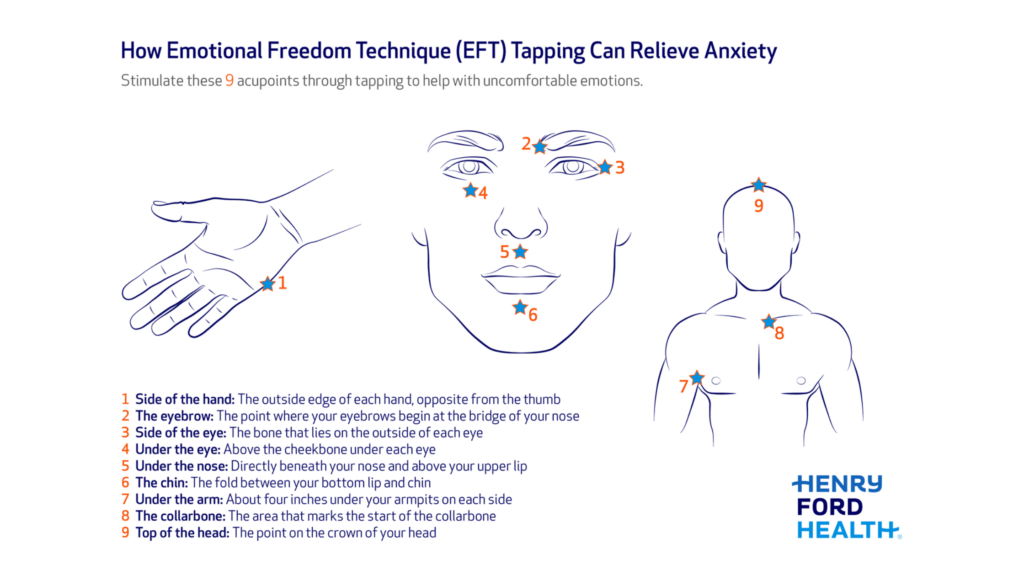Emotional Freedom Technique (EFT), or tapping, is a unique mind-body practice designed to ease physical and mental stress. It’s especially useful for workers in architecture, engineering, and construction (AEC), who frequently face psychological and physical strain. Many workers turn to EFT to relieve anxiety, manage physical pain, and reduce symptoms from chronic health issues. Best of all, it’s completely free (and easy) to do!
Quick look
- EFT works by tapping on specific points on the body to release tension and calm the nervous system.
- Tapping on acupressure points releases stored energy, signaling the brain to reduce cortisol and neutralize emotional intensity.
- EFT includes five easy steps—identifying an issue, rating intensity, tapping through points, and re-assessing—to help you address physical and emotional problems on the go.
- EFT tapping focuses on nine key acupressure points, each associated with different benefits, such as reducing feelings of insecurity and releasing shame.
- Studies show EFT can reduce cortisol levels by up to 24% and lower anxiety intensity by 60% in a single session, providing measurable stress relief.
Tap your way to mind-body balance
The Emotional Freedom Technique (EFT), often known as tapping, blends psychological focus with the ancient practice of acupressure. The idea is simple: tapping on specific points on the body while focusing on a particular issue can release emotional blockages and restore balance in the body’s energy system.
This practice, rooted in Eastern medicine and modern psychology, encourages the body to let go of stress, anxiety, and physical discomfort. People use EFT not only as a tool for emotional support but also as a way to feel more in control of their mental and physical well-being.
What happens when we tap?
The body is thought to hold tension in certain areas depending on how we feel about a stressful situation. When you tap on a specific acupressure point while focusing on a troubling thought or feeling, the energy stored in that point is released and calms the body’s nervous system. It acts like a signal that tells the brain to reduce the production of stress hormones like cortisol. This response helps neutralize the emotional intensity connected to negative memories or stressors, creating a sense of relief and calm.
5 steps to tap into the Emotional Freedom Technique

EFT is a simple, five-step process that you can practice almost anywhere. By following these steps, you can begin to tap into the mind-body connection and work through emotional or physical issues.
1. Identify the issue
Start by focusing on a specific problem you want to address: a feeling, physical pain, or stress about an upcoming event. The more precise you are, the more effective the process will be. You want to ensure you only focus on one issue at a time to maintain clarity and effectiveness throughout the tapping process.
2. Test the intensity
Rate the intensity of your issue on a scale from 0 to 10, with 10 being the most intense. This step helps you track your progress as you move through the process.
3. Setup
Create a simple setup statement that acknowledges the problem while affirming self-acceptance. For example, “Even though I feel [issue], I deeply and completely accept myself.” Repeat this statement while gently tapping the side of your hand, also known as the karate chop point.
4. Tapping sequence
Continue the tapping sequence by lightly tapping each of the main points while focusing on the issue and feeling the associated emotions. Tap about 5–7 times before moving to the next point.
5. Re-test the intensity
After completing the sequence, take a deep breath and rate the intensity of your issue again. If the intensity hasn’t dropped, repeat the process until you notice a decrease.
EFT tapping points

EFT tapping focuses on nine acupressure points, each associated with different benefits. By gently tapping on these areas while concentrating on a specific issue, you can help the body release tension and restore emotional balance. Here are the main tapping points and what they support:
- Karate chop point: Located on the side of your hand, this point sets the stage for tapping by helping to establish focus and intention. It also promotes moving forward, letting go, and becoming happy in the present moment.
- Top of the head: Tapping here may promote calm and unity across the body and mind.
- Eyebrow: This point, found at the start of your eyebrow, is often used to relieve feelings of stress and anxiety.
- Side of the eye: Located at the outer edge of the eye, tapping here can help release resentment and anger and promote clarity and compassion.
- Under the eye: Tapping on the cheekbone below the eye is thought to ease worry, release fear and anxiety, and reduce tension.
- Under the nose: This point, found between the nose and upper lip, is commonly used to release shame or guilt.
- Chin: Located just below the lower lip, tapping here can address insecurity and promote confidence and self-acceptance.
- Collarbone: This point, situated an inch below the collarbone, is associated with releasing stress and grounding energy.
- Underarm: About four inches below the armpit, this point can help release guilt and worry and boost confidence.
These points form the foundation of EFT, allowing for a holistic approach to managing emotional and physical discomfort. Moving through each one supports a full-body reset that encourages calm and clarity.
Benefits of tapping
EFT tapping offers a range of benefits for emotional and physical well-being. While EFT has been around since the 1980s, it wasn’t until a landmark 2012 study that the benefits were fully acknowledged. The study showed that participants who underwent a one-hour EFT session experienced a 24% reduction in cortisol levels, notably higher than the 14% reduction in those receiving traditional talk therapy or no treatment. It also showed a significant decrease in symptoms of anxiety and depression.
Later studies have shown how this process works. The tapping helps engage the amygdala—the brain’s emotional processing center—helping to inhibit or promote the release of hormones that act on our body and promote relaxation. In this way, EFT supports the mind-body connection, allowing people to approach stressful situations or painful memories with a more clear and calm state of mind.
Beyond the studies, EFT has shown promise in alleviating several other health problems and conditions, such as:
- Relief from chronic pain
- Improved stress management
- Enhanced sleep quality
- Decreased PTSD symptoms
- Increased happiness
- Decrease in phobia symptoms
Bottom line
EFT tapping offers a practical, research-backed approach to managing stress, anxiety, and even physical pain. It’s a great alternative health practice for workers in trades struggling to deal with their physical injuries and mental health challenges. With just five simple steps and an accessible technique, EFT allows anyone to actively engage in emotional and physical wellness. While it may not replace traditional therapy for everyone, EFT has proven it can be a powerful addition to a self-care toolkit, helping workers feel more balanced and in control.
Ready to explore more ways to support your well-being? Subscribe to our newsletter for the latest insights on health and wellness and practical tools like EFT to keep you balanced daily.



1 comment